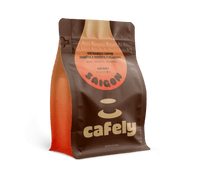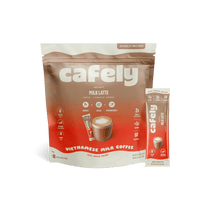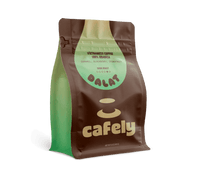Nearly 45 million Americans go on a diet every year — but most don’t see lasting results.
Why?
Because lasting weight loss isn't about extremes, it's about consistency, habits, and small wins that stack up.
This guide shares 25 science-backed weight loss hacks — from smart food swaps to movement tweaks — designed to work with real life, not against it.
Let’s start with the foundation: what and how you eat.
Part 1: Dietary Adjustments
What you eat (and how you eat it) plays a central role in weight loss. These smart, simple food strategies are designed to help you feel full, satisfied, and energized — without counting every calorie.
1. Time Your Meals
Your body has a natural rhythm — and eating in sync with it can help you lose weight.
Time-restricted eating (like eating only between 10 a.m. and 6 p.m.) may help reduce overall calorie intake and improve insulin sensitivity. [2]
- Try the 16:8 method (16-hour fast, 8-hour eating window)
- Stop eating at least 2–3 hours before bedtime
- Keep meal timing consistent day-to-day
This isn't about starving — it's about eating smarter, not later.
2. Reduce Sugar Intake

Americans consume an average of 17 teaspoons of added sugar daily. [3] That’s nearly 3× the recommended amount.
Excess sugar contributes to weight gain, insulin resistance, and cravings for more sugar-laden foods.
Start here:
- Ditch sugary drinks like soda and sweet tea
- Read food labels for hidden names like “fructose” or “maltose”
- Swap in natural sweeteners or unsweetened options
Even cutting just one sugary snack a day can make a noticeable difference.
3. Increase Fiber Intake
Fiber helps you feel full longer and feeds your gut microbes — both crucial for weight loss. [4] High-fiber diets are linked with reduced belly fat and fewer blood sugar crashes.
Focus on:
- Vegetables (especially leafy greens and cruciferous veggies)
- Beans, lentils, and chickpeas
- Whole grains like oats, quinoa, and brown rice
Aim for 25–30 grams of fiber a day to curb hunger naturally.
4. Prioritize Protein
Protein is a weight-loss powerhouse.
It takes more energy to digest, keeps you full longer, and helps preserve lean muscle as you lose fat. [5]
Some smart sources:
- Eggs, Greek yogurt, chicken, fish
- Tofu, lentils, tempeh for plant-based eaters
- A high-protein breakfast can reduce snacking all day
Even small increases in protein intake (up to 30% of your calories) can make a big impact. [6]
5. Stay Hydrated
Thirst is often mistaken for hunger — which can lead to overeating. Drinking water before meals helps reduce appetite and calorie intake. [7]
Try:
- Drinking a glass of water 30 minutes before eating
- Swapping sugary drinks for herbal teas or mushroom coffee for weight loss
- Keeping a refillable water bottle with you at all times
Hydration supports your metabolism, digestion, and energy levels too.
6. Practice Mindful Eating
Mindful eating helps you recognize true hunger cues, stop emotional eating, and slow down. [8]
Tips to get started:
- Eat without screens or distractions
- Chew slowly and savour each bite
- Pause halfway through your meal and check in: still hungry?
This simple habit alone can reduce your intake by hundreds of calories per day.
7. Use Smaller Plates
Trick your brain by downsizing your dishware.
Studies show people may eat less when using smaller plates — even when served the same amount of food. [9]
- Go for 8–9 inch plates instead of 11–12 inch ones
- Portion out snacks into bowls instead of eating from the bag
- Use tall, narrow glasses for beverages
You won’t feel deprived — but your portions will naturally shrink.
8. Limit Liquid Calories
Calories from drinks don’t register the same way as solid food.
Sodas, juices, sweetened coffees, and even smoothies can add up fast without satisfying hunger.
Instead, go for:
- Water with lemon or cucumber
- Sparkling water
- Unsweetened iced tea or coffee
Cutting out just one sugary drink per day could save you over 100 calories — and support fat loss over time. [10]
Pro Tip: If you want a clean caffeine boost without added sugar or cream, try VC2 — a functional Vietnamese coffee infused with adaptogens, nootropics, and zero added sugar. It’s designed for sustained energy, appetite control, and sharper focus — without the crash.
9. Incorporate Spices
Spices do more than just flavor your food — some may boost your metabolism, too.
Capsaicin (in chili peppers) and cinnamaldehyde (in cinnamon) have both been linked to mild increases in fat burning and appetite control. [11]
Try adding:
- Cayenne pepper to eggs, soups, or roasted veggies
- Cinnamon to oatmeal or coffee
- Turmeric for anti-inflammatory support
Every small edge adds up — and this one also tastes great.
10. Use Pre-Meal Strategies

Eating the right foods before meals can help curb overeating.
Start with low-calorie, high-volume options that help fill you up before the main course.
Try:
- A small salad with olive oil and vinegar
- Bone broth or veggie soup
- An apple or handful of almonds
This hack works especially well at restaurants or buffet-style meals.
11. Snack Smart
Snacking itself isn’t the problem — mindless snacking is.
The right snacks can keep your energy stable and reduce overeating at mealtime. [12]
Good options:
- Greek yogurt with berries
- Carrot sticks and hummus
- A boiled egg or handful of almonds
Pair protein with fiber for best results.
12. Limit Processed Foods
Processed foods are designed to be hyper-palatable — and hard to stop eating. [13] They often contain hidden sugar, refined carbs, and fats that promote weight gain.
Stick to:
- Single-ingredient, whole foods
- Home-cooked meals
- Ingredient lists with 5 or fewer items
Your energy, digestion, and weight will thank you.
13. Eat at Consistent Times
Eating at irregular times can confuse your hunger hormones.
People who eat on a consistent schedule tend to have better blood sugar control and fewer cravings. [14]
Aim to:
- Eat meals around the same time daily
- Avoid skipping meals, especially breakfast
- Keep a regular pattern on weekends too
Even slight routine shifts can improve metabolic balance over time.
Physical & Lifestyle Hacks That Make a Real Difference
Losing weight isn’t just about food — how you move, sleep, and structure your day matters just as much. These lifestyle upgrades help boost your metabolism, build consistency, and support fat loss from the ground up.
14. Interval Walking Training (IWT)
If you're looking for an easy, no-gym-required boost to your fat-burning, interval walking is a smart move.
Studies show that alternating short bursts of brisk walking with slower recovery periods improves cardiovascular health and increases calorie burn — even more than walking at a steady pace. [15]
It’s especially great for beginners or older adults looking for low-impact but effective workouts. Just 30 minutes a day can make a measurable difference in your fitness.
15. Strength Training
Strength training does more than tone your body — it revs up your metabolism.
Lifting weights or doing resistance exercises helps build lean muscle, which burns more calories at rest than fat. [16] This means your body keeps working even when you're not.
Aim for two to three strength sessions per week focusing on major muscle groups like legs, back, and chest.
16. High-Intensity Interval Training (HIIT)
Short on time? HIIT is your solution.
This workout style involves intense bursts of activity (like sprinting or burpees) followed by short rests. It’s been shown to burn more fat in less time compared to moderate steady-state cardio. [17]
Plus, HIIT continues to torch calories even after your workout ends, thanks to a phenomenon called excess post-exercise oxygen consumption (EPOC).
17. Consistent Movement
Sitting is the new smoking, and many of us do it for hours on end.
Incorporating consistent movement into your daily life — standing up every hour, stretching, taking the stairs, or walking while on phone calls — helps increase your non-exercise activity thermogenesis (NEAT). [18]
These tiny efforts add up and can significantly raise your total daily energy expenditure.
18. Active Commuting

Walking or biking to work isn’t just eco-friendly — it can also contribute to better weight control.
Even short, daily biking helps regulate appetite, improve insulin sensitivity, and keep your heart in shape. [19]
If your schedule or location makes active commuting difficult, try parking further from your destination or getting off one bus stop early to squeeze in a few extra steps.
Behavioral & Lifestyle Modifications
Your mindset and daily habits shape how well weight loss efforts stick. These strategies help rewire the behaviors behind eating, motivation, and long-term success — without relying on willpower alone.
19. Regular Sleep Patterns
Getting enough sleep might be the most underrated weight loss strategy.
Poor sleep disrupts hormones like leptin and ghrelin, which regulate hunger and fullness. It also reduces willpower, making unhealthy snacking more likely. [20]
Aim for seven to nine hours of quality sleep per night, and try to keep a consistent bedtime — even on weekends — to support your body’s natural rhythm.
20. Stress Management
Stress activates cortisol, a hormone linked to increased appetite and fat storage, especially around the midsection. [21] Chronic stress also drives emotional eating and cravings for high-sugar, high-fat foods.
Integrating mindfulness, yoga, breathwork, or even adaptogenic beverages (like mushroom coffee for weight loss) into your routine can help calm the mind and support fat loss from the inside out.
21. Set Realistic Goals
Extreme expectations can sabotage progress.
Instead of aiming to lose 20 pounds in a month, focus on small, achievable wins — like preparing healthy lunches for the week or walking 20 minutes each day.
Realistic goals build momentum and confidence, making the process more sustainable long term. The slower, steadier route is usually the one that sticks.
22. Track Progress
What gets measured gets managed. Whether it’s food intake, workout frequency, or steps walked per day, tracking habits helps you stay accountable.
Tools like fitness apps, journals, or even smart watches can highlight patterns, helping you adjust before results plateau.
Seeing progress, even in small increments, can also boost motivation and consistency.
23. Seek Support
Weight loss is easier when you’re not doing it alone.
Support can come from many places: a friend with similar goals, a personal trainer, an online accountability group, or even a registered dietitian.
Social connection keeps you motivated, helps troubleshoot setbacks, and provides emotional backing when you hit rough patches.
Nutritional Supplements & Alternatives
While no supplement can replace healthy habits, the right tools can offer extra support. These science-backed options may help curb cravings, boost metabolism, or simplify your routine when life gets hectic.
24. Herbal Supplements
Some natural herbs show promise for weight control — when paired with lifestyle changes. [22]
For example:
- Fenugreek may increase satiety and reduce appetite.
- Ginger can improve digestion and blood sugar control.
- Green tea extract is rich in catechins, which help increase fat burning.
Natural doesn’t always mean safe. Always research and speak with a healthcare professional before trying new supplements.
25. Meal Replacements
When used strategically, meal replacements can help reduce calorie intake while still providing essential nutrients. [23]
A balanced shake or smoothie with protein, healthy fats, and fiber can keep you full and prevent impulsive snacking. This method is especially effective for those with busy schedules or trouble with portion control.
If you're looking for alternatives to sugar-heavy beverages, understanding the coffee loophole can offer additional insights into curbing cravings while staying energized.
Common Setbacks & How to Overcome Them
Even the best weight loss hacks can hit a wall. Plateaus, emotional eating, and lifestyle disruptions are common — but not permanent.
Here’s how to navigate these challenges using natural weight loss methods and easy weight loss tips that actually work.
1. Plateaus
You’ve cut calories, exercised regularly, and seen results — until you didn’t. Suddenly, your progress stalls.
This plateau is normal. As your body sheds weight, it burns fewer calories, which slows further loss. It’s not failure — it’s physiology.
How to break through:
- Recalculate your calorie needs based on current weight
- Add or intensify strength training to boost resting metabolism
- Switch up your cardio routine — try swimming instead of jogging, or a HIIT workout instead of your usual walk
Even minor changes in activity or meal timing can reignite progress. If you're drinking coffee to support your workouts, try combining it with a metabolism-friendly option like mushroom coffee — some ingredients may aid energy and fat metabolism.
2. Emotional Eating
Stress, sadness, and even boredom can trigger emotional eating. You reach for food not because you’re hungry — but because you’re feeling something else.
The fix:
- Practice intentional eating: pause before snacking and ask yourself if you’re physically hungry
- Keep a mood-food journal to identify triggers
- Replace food with soothing habits — a short walk, journaling, or calling a friend
You don’t need to be perfect. One emotional snack doesn’t erase weeks of progress. Compassion goes further than criticism when building healthy habits.
3. Unrealistic Expectations
In the age of 7-day “detoxes” and before/after selfies, it’s easy to expect rapid weight loss. But natural weight loss methods take time.
Reframe your mindset:
- Set SMART goals (Specific, Measurable, Achievable, Relevant, Time-bound) [24]
- Track non-scale wins — better energy, clearer skin, improved sleep
- Celebrate consistency, not just the numbers
Think of these changes not as temporary fixes, but permanent upgrades to your well-being.
4. All-or-Nothing Mentality
You eat one slice of cake and think, “Well, today’s ruined.” Sound familiar?
This mindset turns one choice into a full derailment. And it’s one of the biggest enemies of consistent progress.
Reset your thinking:
- One indulgence doesn’t undo all your work
- Return to your normal routine at the next meal — no need to “make up for it”
- Focus on patterns, not perfection
Remember, sustainable weight loss hacks are about balance — not restriction.
5. Overlooking Hidden Calories

Sauces, dressings, fancy coffee drinks — they can quietly sabotage your calorie goals. Even something as simple as your morning brew might be adding more than you realize, depending on what you put in it. Be mindful of the calories in coffee, especially when sweeteners, milk, or flavored syrups are involved.
Simple swaps:
- Use vinaigrette or lemon juice instead of creamy dressings
- Ask for sauces on the side at restaurants
- Check labels — “healthy” snacks like protein bars often pack more sugar than expected
And for your daily brew, consider a natural way to sweeten your coffee without sugar — it’s one of the easiest weight loss tips that pays off over time.
6. Skipping Meals
You might think skipping breakfast saves calories — but it often backfires. By lunchtime, hunger hits hard, and you may overeat without realizing it.
What to do instead:
- Eat a protein-rich breakfast to reduce cravings later in the day
- Don’t wait until you're starving — build regular meal rhythms
- Pack healthy snacks to prevent impulsive eating
Consistent nourishment helps regulate blood sugar and maintain energy — both crucial for weight loss success.
7. Lack of Sleep
Sleep deprivation disrupts two key hormones: ghrelin (which boosts hunger) and leptin (which tells you you’re full). The result? You crave more, especially carbs.
Sleep smarter:
- Aim for 7–9 hours of sleep per night
- Keep your bedtime and wake time consistent — even on weekends
- Avoid screens and caffeine an hour before bed
Improving sleep is one of the most underrated weight loss hacks. It resets your hormones and supports your metabolism naturally.
8. Social Pressures
Family dinners, holidays, or nights out with friends can create awkward food scenarios. Peer pressure can nudge you toward second helpings or sugary cocktails.
How to handle it:
- Eat a high-fiber snack before gatherings to avoid arriving hungry
- Politely decline or serve yourself smaller portions
- Focus on the company, not just the food
And if you're at a café or social event, order something lighter like unsweetened tea or pure black coffee — or check out options like Vietnamese coffee, which can be both satisfying and waistline-friendly when served without sugar.
9. Inconsistent Physical Activity
Movement doesn’t need to mean an hour at the gym — but it does need to happen regularly.
Make it stick:
- Schedule workouts like appointments — put them in your calendar
- Choose what you enjoy — dancing, hiking, even active cleaning counts
- Track your steps or activity for daily motivation
One of the easiest weight loss tips is just moving more throughout the day — take the stairs, pace during calls, or go for a quick walk after meals.
10. Medical Conditions & Medications
Sometimes, despite your best efforts, weight won’t budge. Certain health issues — like thyroid imbalances or insulin resistance — can interfere with your progress. So can some medications.
What to do:
- Don’t blame yourself — consult your doctor
- Get blood work done if you suspect an issue
- Ask about alternatives if a medication is contributing to weight gain
Your health story is unique, and working with a provider can uncover hidden barriers and create a more personalized plan for weight management.
Lifestyle Changes That Support Weight Loss
1. Keep Moving Daily
Consistent movement matters more than perfection. Whether it’s structured workouts or active living — like taking stairs, walking pets, or stretching during screen breaks — keeping your body engaged helps regulate your appetite and maintain your progress.
2. Weigh Yourself Weekly
Stepping on the scale once a week can increase accountability without obsession. It helps you spot upward trends early and adjust your approach without panic. For some, non-scale metrics (like energy, sleep, or how clothes fit) may also be useful markers.
3. Eat Like You're Nourishing, Not Restricting
A long-term shift in how you view food makes a big difference. Fill your meals with whole ingredients — vegetables, lean proteins, complex carbs, and healthy fats. Minimize refined products and sugar-sweetened beverages.
4. Set Clear, Realistic Targets
Shooting for extreme outcomes can backfire. Instead, aim for realistic, attainable wins — like adding two veggies to your meals each day or walking 20 minutes every morning. Clarity fuels consistency.
5. Work With Professionals
Health coaches, nutritionists, or even informed communities can keep you focused when motivation dips. Having someone to ask questions, troubleshoot challenges, or cheer you on can make weight loss feel less isolating and more achievable.
Turn Smart Tips Into Lasting Change
Weight loss isn’t just about willpower — it’s about strategy.
These roadblocks are common, but they’re also solvable with the right mindset and science-backed tools. The best weight loss hacks are simple, sustainable, and built for real life.
Whether you’re tackling emotional eating, adjusting your workouts, or swapping sugary drinks for smarter options, small changes can lead to big results.
Let your next step be the one that sticks.
Top 10 FAQs About Weight Loss

1. What Is the Most Effective Diet for Weight Loss?
There’s no one-size-fits-all. The most effective diets are built around whole, unprocessed foods, steady eating patterns, and consistency over time — not extremes.
2. How Much Exercise Is Needed Weekly?
Aim for 150 minutes of moderate activity like brisk walking or cycling, plus two days of strength-based movement for lasting body composition changes.
3. Can I Lose Weight Without Exercise?
Yes — creating a calorie deficit through food alone can work. But pairing movement with mindful eating improves long-term results and overall health.
4. How Important Is Sleep in Weight Loss?
Very. Sleep influences hormones tied to appetite, energy storage, and cravings. Poor sleep often leads to impulsive eating and low energy the next day.
5. Are Weight Loss Supplements Effective?
Some (like green tea or fiber-based supplements) may help, but they work best when paired with strong nutrition and movement habits — not on their own.
6. How Do I Handle Cravings?
Start by identifying what’s triggering them — stress, boredom, blood sugar dips? Try herbal teas, movement, or whole-food snacks to manage urges without guilt.
7. Is It Normal to Hit a Weight Loss Plateau?
Absolutely. As your body adapts, changes slow down. Adjust your intake, swap up your movement, or add strength work to reignite progress.
8. How Quickly Should I Expect to Lose Weight?
Losing 0.5 to 1 kg (1–2 pounds) per week is a safe, sustainable pace. Faster loss often rebounds unless lifestyle habits are fully in place.
9. Does Drinking Water Aid Weight Loss?
Yes — water can reduce hunger between meals, support digestion, and even slightly increase calorie burn. It’s also a great swap for high-calorie drinks.
10. Should I Avoid All Fats?
Not at all. Healthy fats — like those from avocados, nuts, or olive oil — support hormone balance and keep you fuller longer. Avoid only trans fats and excess saturated fat.
References:
- Boston Medical Center. (2017, September 7). Weight Management. Boston Medical Center.
- Wilkinson, M. J., Manoogian, E. N. C., Zadourian, A., Lo, H., Fakhouri, S., Shoghi, A., Wang, X., Fleischer, J. G., Navlakha, S., Panda, S., & Taub, P. R. (2020). Ten-Hour Time-Restricted Eating Reduces Weight, Blood Pressure, and Atherogenic Lipids in Patients with Metabolic Syndrome. Cell Metabolism, 31(1), 92-104.e5.
- CDC. (2024, May 14). Get the Facts: Added Sugars. Nutrition.
- Holscher, H. D. (2017). Dietary Fiber and Prebiotics and the Gastrointestinal Microbiota. Gut Microbes, 8(2), 172–184.
- Moon, J., & Koh, G. (2020). Clinical Evidence and Mechanisms of High-Protein Diet-Induced Weight Loss. Journal of Obesity & Metabolic Syndrome, 29(3), 166–173.
- Moon, J., & Koh, G. (2020). Clinical Evidence and Mechanisms of High-Protein Diet-Induced Weight Loss. Journal of Obesity & Metabolic Syndrome, 29(3), 166–173.
- Dennis, E. A., Dengo, A. L., Comber, D. L., Flack, K. D., Savla, J., Davy, K. P., & Davy, B. M. (2009). Water Consumption Increases Weight Loss During a Hypocaloric Diet Intervention in Middle-aged and Older Adults. Obesity, 18(2), 300–307.
- Nelson, J. B. (2017). Mindful Eating: The Art of Presence While You Eat. Diabetes Spectrum, 30(3), 171–174.
- Kosīte, D., König, L. M., De-loyde, K., Lee, I., Pechey, E., Clarke, N., Maynard, O., Morris, R. W., Munafò, M. R., Marteau, T. M., Fletcher, P. C., & Hollands, G. J. (2019). Plate size and food consumption: a pre-registered experimental study in a general population sample. International Journal of Behavioral Nutrition and Physical Activity, 16(1).
- Hall, K. D., & Kahan, S. (2018). Maintenance of lost weight and long-term management of obesity. Medical Clinics of North America, 102(1), 183–197. Ncbi.
- Szallasi, A. (2022). Capsaicin for Weight Control: “Exercise in a Pill” (or Just Another Fad)?. Pharmaceuticals, 15(7), 851.
- Njike, V. Y., Smith, T. M., Shuval, O., Shuval, K., Edshteyn, I., Kalantari, V., & Yaroch, A. L. (2016). Snack Food, Satiety, and Weight. Advances in Nutrition, 7(5), 866–878.
- Fazzino, T. L., Dorling, J. L., Apolzan, J. W., & Martin, C. K. (2021). Meal composition during an ad libitum buffet meal and longitudinal predictions of weight and percent body fat change: The role of hyper-palatable, energy-dense, and ultra-processed foods. Appetite, 167, 105592.
- Fleischer, J. G., Das, S. K., Bhapkar, M., Manoogian, E. N. C., & Panda, S. (2022). Associations between the timing of eating and weight-loss in calorically restricted healthy adults: Findings from the CALERIE study. Experimental Gerontology, 165, 111837.
- Atakan, M. M., Li, Y., Koşar, Ş. N., Turnagöl, H. H., & Yan, X. (2021). Evidence-Based Effects of High-Intensity Interval Training on Exercise Capacity and Health: A Review with Historical Perspective. International Journal of Environmental Research and Public Health, 18(13), 7201.
- Willis, L. H., Slentz, C. A., Bateman, L. A., Shields, A. T., Piner, L. W., Bales, C. W., Houmard, J. A., & Kraus, W. E. (2012). Effects of aerobic and/or resistance training on body mass and fat mass in overweight or obese adults. Journal of Applied Physiology, 113(12), 1831–1837.
- Foster, C., Farland, C. V., Guidotti, F., Harbin, M., Roberts, B., Schuette, J., Tuuri, A., Doberstein, S. T., & Porcari, J. P. (2015). The Effects of High Intensity Interval Training Vs Steady State Training on Aerobic and Anaerobic Capacity. Journal of Sports Science & Medicine, 14(4), 747.
- von Loeffelholz, C., & Birkenfeld, A. (2022). The Role of Non-exercise Activity Thermogenesis in Human Obesity (K. R. Feingold, B. Anawalt, A. Boyce, G. Chrousos, K. Dungan, A. Grossman, J. M. Hershman, G. Kaltsas, C. Koch, P. Kopp, M. Korbonits, R. McLachlan, J. E. Morley, M. New, L. Perreault, J. Purnell, R. Rebar, F. Singer, D. L. Trence, & A. Vinik, Eds.). PubMed; MDText.com, Inc.
- Bird, S. R., & Hawley, J. A. (2017). Update on the Effects of Physical Activity on Insulin Sensitivity in Humans. BMJ Open Sport & Exercise Medicine, 2(1), e000143.
- Van Egmond, L. T., Meth, E. M. S., Engström, J., Ilemosoglou, M., Keller, J. A., Vogel, H., & Benedict, C. (2022). Effects of acute sleep loss on leptin, ghrelin, and adiponectin in adults with healthy weight and obesity: A laboratory study. Obesity, 31(3).
- Chao, A. M., Jastreboff, A. M., White, M. A., Grilo, C. M., & Sinha, R. (2017). Stress, cortisol, and other appetite-related hormones: Prospective prediction of 6-month changes in food cravings and weight. Obesity, 25(4), 713–720.
- Koithan, M., & Niemeyer, K. (2010). Using Herbal Remedies to Maintain Optimal Weight. The Journal for Nurse Practitioners, 6(2), 153–154.
- Kim, J. Y. (2020). Optimal diet strategies for weight loss and weight loss maintenance. Journal of Obesity & Metabolic Syndrome, 30(1), 20–31.
- Stewart, V. (2024). Are SMART goals fit-for-purpose? Goal planning with mental health service-users in Australian community pharmacies. International Journal for Quality in Health Care, 36(1).












